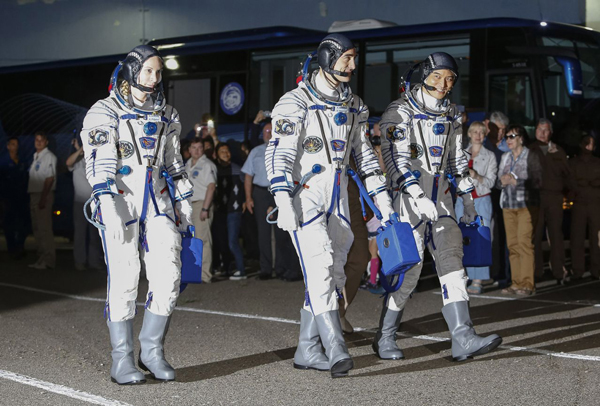当前位置: Language Tips> 双语新闻
NASA on the hunt for space poop geniuses
如果奔赴火星途中你裹在宇航服中,可是你又迫切需要“解决问题”,怎么办呢?现实中,宇航员们就因为穿着笨拙的宇航服而无法接触自己的身体,加上完全失重状态下排泄物很难清理,因此,在太空上厕所成了一大难问题。近日,美国航空航天局(NASA)拿出3万美元,用以奖励能切实解决“太空排泄”难题的人。

When you've got to go, but you're out there in space, zipped up in a spacesuit, with no toilet in sight and a crew of other astronauts around, what do you do?
如果你在太空裹着宇航服时,迫切需要方便一下,但是周围看不到厕所又有一群宇航员在,你要怎么办呢?
NASA has launched a contest for inventors to solve this uncomfortable issue, and promises to award $30,000 to the best "space poop" solutions.
为了解决“太空排便”这个让人难受的问题,美国宇航局发起了一场发明征集赛,最佳方案可以获得3万美金奖励。
Inventors have until December 20 to submit designs for a personalized waste-wicking system that will handle everything, hands-free, for a period of up to six days.
参与者需在12月20日前递交个性化的排泄物处理系统,该方案要能够解决所有问题、不用手且持续周期最多为6天。
"The old standby solution consisted of diapers," said the description of contest details at www.herox.com/SpacePoop.
www.herox.com/SpacePoop网站在比赛细则中描述道,“老办法是用尿布。”
"However, the diaper is only a very temporary solution, and doesn’t provide a healthy/protective option longer than one day."
“然而,这只是一个临时解决方案,尿布使用超过一天就没办法保证健康和防护性。”
Sometimes, astronauts have to wait even longer. The two men and one woman who packed themselves into a Russian Soyuz space capsule last week had to wait two full days between launching from Kazakhstan and arriving at the International Space Station.
有时候,宇航员甚至要等得更久。上周,两名男性和一名女性进入了俄罗斯联盟号太空舱,从太空舱在哈萨克斯坦发射起到抵达国际空间站,期间他们必须等待两天。
 |
| U.S. astronaut Kate Rubins, left, Russian cosmonaut Anatoly Ivanishin, centre, and Japanese astronaut Takuya Onishi |
The Soyuz is equipped with a portable toilet, which looks like an air-powered pee jug.
“联盟号”配备了便携式厕所,它看起来像是一个空气动力小便壶。
On future missions to deep space destinations like an asteroid or Mars, NASA suspects it could take up to 144 hours, or six days, to get to a proper toilet.
未来太空任务的目的地是小行星或是火星之类更远的地方,美国宇航局猜测,宇航员们可能要坚持6天才能找到一个合适的厕所。
In emergency situations, astronauts may need to zip themselves into a fully pressurized, bulky orange spacesuit, complete with helmet and gloves.
在紧急情况下,宇航员可能需要将自己包裹在完全加压的、配有头盔和手套的笨重橙色宇航服中。
"While sealed, it is impossible for an astronaut to access their own body, even to scratch their nose," NASA said.
“因为宇航服是密封的,所以宇航员不可能触碰到自己的身体,他们连自己的鼻子都摸不到。”
That's where the inventors come in. Astronauts need some way to clear away urine, fecal matter and menstrual blood efficiently, or they risk infection.
这正是需要发明家的地方。宇航员需要有效清除尿液、粪便以及经血的方法,否则就有感染的风险。
The problem is that in weightlessness, fluids can blob up and stick to surfaces, while solids float in the air.
问题是,在失重状态下液体变成水珠浮于表面,而固体会漂浮在空中。
"You don't want any of these solids and fluids stuck to your body for six days," NASA said, recalling how easy babies can get diaper rash.
美国宇航局表示,“你不会想要任何这类固体和液体在身上停留6天时间。”这让人联想到婴儿很容易得尿布疹。
Currently, while at the International Space Station, astronauts use a toilet contraption that includes a vacuum and a tube to help evacuate fecal matter.
目前,宇航员在国际空间站使用的厕所装置包含帮助输导粪便的真空泵和管道。
To urinate, they use a funnel attached to a hose that can be adapted for a sitting or standing position, and uses air to move urine away.
他们小便时使用一个漏斗,这个漏斗连接的软管,使得坐姿或站姿都可使用,并通过空气将尿液清除。
NASA vowed to award up to three $30,000 prizes for the most promising in-suit waste management systems.
美国宇航局承诺,对最出色的宇航服内部排污管理系统奖励3万美元,最多奖励三人。
The goal is to test them within a year and fully implement them within three years.
他们的目标是在一年内测试系统,并在三年内全面应用。
NASA says the first human missions to Mars could take place by the 2030s.
美国宇航局表示,可能于本世纪30年代实现首次人类火星登陆任务。
英文来源:法新社
翻译:董静
编审:yaning
上一篇 : 昂贵的驴奶酪 每公斤880英镑
下一篇 : 早餐吃冰淇淋让你变聪明?
关注和订阅


电话:8610-84883645
传真:8610-84883500
Email: languagetips@chinadaily.com.cn